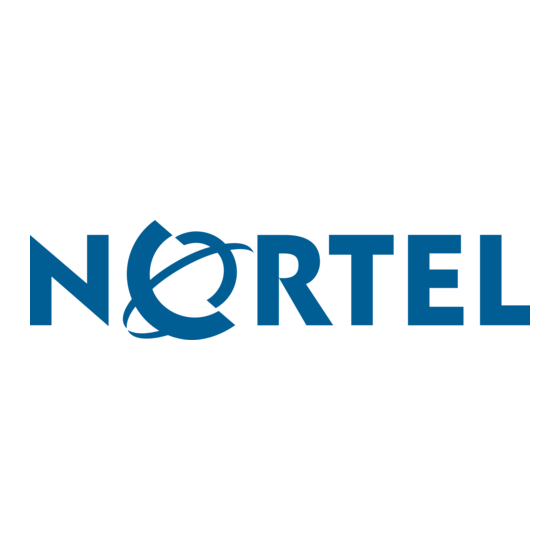
Table of Contents
Advertisement
Quick Links
Voice Messaging
User Guide
© 1987, 1988, 1989, 1990, 1991, 1992, 1993, 1994, 1996, 1998 Northern Telecom
All rights reserved
Information is subject to change since Northern Telecom reserves the right, without notice, to make changes in equipment
design or components as progress in engineering or manufacturing methods may warrant.
Touch tone is a trademark of Bell Canada.
P0875935
Standard 1.0 January 1998
Printed in
U.S.A.
Product release
MM12
MMUI
Advertisement
Table of Contents

Summary of Contents for Nortel 1998
- Page 1 Voice Messaging User Guide © 1987, 1988, 1989, 1990, 1991, 1992, 1993, 1994, 1996, 1998 Northern Telecom All rights reserved Information is subject to change since Northern Telecom reserves the right, without notice, to make changes in equipment design or components as progress in engineering or manufacturing methods may warrant.
- Page 2 Welcome to Voice Messaging Voice Messaging is an electronic voice messaging system that gives you a convenient and dependable way to communicate with people both inside and outside your organization. Voice Messaging answers your calls when you are on or away from your phone, and also allows you to compose, edit, and send messages forward and reply to messages...
-
Page 3: Table Of Contents
Notes Contents Help ....................Your Voice Messaging numbers............Introduction to Voice Messaging ............Voice Messaging at a glance............Logging in ..................Changing your password ..............Recording your name (personal verification) ........Recording external, internal, and temporary greetings ..... Playing your messages ..............Replying to messages................ -
Page 4: Help
Help Introduction to Voice Messaging You can get help at any time while using Voice Messaging. The help is How to use this guide Prompts context-sensitive. This means that when you press the help key, you are This guide explains how to use Voice Messaging guides you with Voice Messaging. -
Page 5: Voice Messaging At A Glance
Voice Messaging at a glance Message commands Message options Playback options Main commands Decrease Decrease Increase Reply Play Forward Urgent Standard Economy speed speed speed envelope Reply all Compose Delete/ Private Acknow- Timed ledge delivery restore Skip Play Skip backward forward Send Message... -
Page 6: Logging In
Logging in Changing your password Logging in means accessing your mailbox in the Voice Messaging system so For security reasons, you should change your password from the one you were first that you can play your messages and use all the other Voice Messaging features. assigned. -
Page 7: Recording External, Internal, And Temporary Greetings
Recording external, internal, and temporary greetings Playing your messages Callers from outside your organization hear your external greeting; callers Your phone may have a message-waiting light to indicate new messages, or you within your organization hear your internal greeting. All callers hear your may hear a special dial tone when you pick up the handset. -
Page 8: Replying To Messages
Replying to messages Calling the sender You can record a reply to a message sender, and send your reply to all the other After listening to a message, you can automatically place a call to the sender of recipients of the message, if they are known to Voice Messaging. the message, if the sender is known to Voice Messaging. -
Page 9: Thru Dialing
Thru dialing Express messaging While you are logged in to Voice Messaging, you can make a call without Express messaging is a fast method of leaving a message in another Voice hanging up. Ask your system administrator if thru dial is available in your Messaging mailbox without logging in to your own mailbox to compose and system. -
Page 10: Composing Messages
Composing messages Composing messages (continued) You can compose a message to one or more people or distribution lists, then If this option is available on your system, you can address messages to other sites edit the message if necessary, and send it when you are ready. You address your (networks), to other voice mail systems (open networks), and to recipients with message before recording it. -
Page 11: Checking And Editing Your Messages
Checking and editing your messages Distribution lists Before you send a message which you have recorded, you can check it and edit A distribution list saves you time when you are sending a message to a group of it if required. addresses. -
Page 12: Tagging Messages
Tagging messages Tagging messages (continued) When you create a message you can tag it to indicate that you want it handled You tag a message before sending it. You can use one or more tags per message, in a special way. There are six message tagging options. and you can remove and change tags. -
Page 13: Remote Notification
Tagging messages (continued) Remote notification (continued) To remove a tag Remote notification calls the telephone number you have specified and tells you ‡‚ that a message has been received for you. Before sending a message, you can “Message options.” ¤ To answer a remote notification call remove a tag. - Page 14 Remote notification (continued) Remote notification (continued) You can define up to three remote notification schedules, with up to three time You can review, change, or add to the schedules and time periods you have periods per schedule. defined. To set up remote notification To modify remote notification °‚...
- Page 15 Family Product Manual Contacts Copyright FCC notice Trademarks Document number Product release Document release Date Publish Copyright Statement © 1998 Northern Telecom All rights reserved Information is subject to change without notice. Northern Telecom reserves the right to make changes in design or components as progress in engineering and manufacturing may warrant.














Need help?
Do you have a question about the 1998 and is the answer not in the manual?
Questions and answers